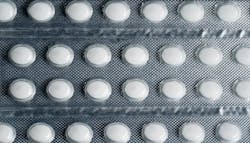While small molecule drugs are still an important source of innovation for pharmaceutical companies, they come with a unique set of formulation challenges. Advanced drug discovery efforts continuously unearth new small-molecule drug candidates in critical areas such as oncology, but these compounds often have complex molecular structures and poor water solubility.
Between 40-70% of marketed drugs, and up to 90% of all new chemical entities (NCEs), suffer from poor water solubility, which may ultimately reduce bioavailability i.e., the proportion of the drug substance that enters systemic circulation. This can reduce the therapeutic effect, making it challenging to turn these promising molecules into real drug products.
The complexity of new small molecule treatments has downstream effects on formulators and manufacturers, who need to find ways to address poor water solubility in otherwise promising drug candidates.
But where challenges exist, so too do opportunities. Many manufacturers are now investigating ways to not only maximize the chances of successfully bringing a new API to market, but also improve the efficacy of APIs that have already been approved. One familiar tool is proving invaluable: excipients.
Excipients examined
Over recent years, the excipient market landscape has transformed. Drug developers are no longer looking only for simple binders and fillers to package up their APIs, but for functional excipients that can help them improve drug delivery and bring highly differentiated products to market. This has been largely driven by the rise in poorly soluble drugs, highly potent APIs (HPAPIs), and the patent expiry of blockbuster medications.
Functional excipients can be broadly grouped into four categories: solubility enhancers, release modifiers, suspending agents, and viscosity modifiers. Solubility enhancers modify an API to ensure it has a therapeutic effect — either by improving its dissolution or by increasing its bioavailability. For example, amorphous solutions and dispersions (ASDs) are used to increase solubility by disrupting the crystalline structure of the API and maintaining it in a more soluble amorphous state. By using the right excipient, manufacturers can stabilize the drug in its amorphous form while simultaneously facilitating a much higher drug load, boosting bioavailability.
Release modifiers are designed to increase the timeframe over which a drug is released in the body, extending it from less than an hour to potentially 12 or more hours. These excipients can be highly beneficial when looking to improve the patient experience, as they can reduce the number of doses needed within a particular timeframe.
Through excipient-led approaches, such as matrix tablets, functional coatings, or even multi-particulate systems, formulators can extend the release profile from a single tablet or capsule, greatly improving patient adherence and treatment outcomes over the long-term. Extended-release tablets are especially useful when treating chronic diseases such as diabetes, as these conditions require patients to adhere to their medication over many years.
Suspending agents, meanwhile, improve the shelf life and stability of liquid formulations by maintaining homogeneity and preventing the drug from separating out. Beyond this, a high-quality excipient can help manufacturers tweak the more aesthetic properties of a medication, such as texture and mouthfeel, to improve the patient experience. Reformulating can also improve accessibility — for example, by converting a tablet into a liquid to mitigate swallowing difficulties in elderly or pediatric populations.
Much like suspending agents, viscosity modifiers help formulators maintain their drug’s stability and shelf-life properties. The key difference is that viscosity modifiers are mainly used in topical formulations to make gels, creams, or ointments that have desirable aesthetic properties for patients. When using a high-quality excipient, ideal suspension properties can be achieved without significantly affecting viscosity. This allows formulators to achieve a wide range of viscosities while maintaining a stable particle distribution, helping meet their target product profile while still delivering key patient-centric properties.
Is it prime time for novel excipients?
Though good functional excipients are invaluable, bringing new ones to market can be challenging. The pharma industry is typically a conservative one, and excipient selection is primarily driven by precedence of use and recent clinical or market success. This can hinder innovation. In a 2020 US Pharmacopeia survey of drug formulators, 84% said that the current roster of excipients present in approved drug products has imposed limitations on drug development, and as many as 28% experienced a discontinuation of drug development as a result of excipient limitations.
However, with the growing complexity of pipeline APIs, novel excipients are receiving renewed interest as a route to enabling more poorly soluble, 'brick-dust' APIs to reach the market. New excipient technologies can help formulators work around the existing shortcomings of traditional excipients to improve existing formulations, or even rescue compounds from failing in early pre-clinical testing. Thankfully, to serve this pipeline of challenging APIs and ensure more treatments can get to market, several companies are developing new excipients, and the industry is getting on board.
In 2021, the FDA's Center for Drug Evaluation and Research (CDER) launched the Pilot Program for the Review of Innovation and Modernization of Excipients (PRIME), a program designed to streamline the journey of novel excipients to market. With organizations like the International Pharmaceutical Excipients Council (IPEC) now working with regulators to develop a clear review pathway and guidelines for novel excipients, the future for excipient innovation looks bright.
Choosing the right excipient for the job
So, with the myriad excipient options available to drug manufacturers, what should they choose? Firstly, the choice of excipient is one that should be made during the early stages and after the target product profile (TPP) has been defined. This is crucial because, from a technical standpoint, a drug may need improved solubility or higher drug loading to meet the TPP.
In terms of safety, manufacturers need to consider the route of administration when choosing an excipient and run the appropriate safety and toxicity tests. It is also important to work with a supplier who understands what it takes to scale up the excipient for GMP manufacturing and who can provide all the regulatory and safety/tox testing that the FDA will require.
Residual solvents are another factor to examine, as these can impact the safety of a product if mitigation strategies aren’t in place. Many excipient manufacturers are now moving towards more toxicologically preferred solvents, such as ethyl acetate, and all reputable suppliers test for applicable residual solvents to ensure full compendial compliance. This can streamline raw material testing and final product approval for pharmaceutical developers, helping to further ensure patient safety.
Patient concerns, such as ease of administration and reduction of side effects, should also ideally be addressed. It can be beneficial for developers to look for highly efficient excipients that require lower usage levels in the formulation. This can help to reduce pill size or make room for the addition of flavors or colorings to make the drug more palatable, which in turn can improve patient comfort and compliance.
In addition to enhancing the drug product from a patient perspective, it is also vital to factor in commercial considerations — in particular, intellectual property (IP) strategy and regulatory pathway. IP is critical for any new drug coming to market, as patents allow protection against generic competition and ensure drugs are commercially viable. It is also important when looking to develop an improved version of an existing drug product, such as taking an existing API and reducing the pill size, making it easier to inject, or completely switching dosage forms (e.g., moving from an injection to the more convenient oral route). Novel excipients can help here, too, by facilitating the development of new IP, enabling use of the 505(b)(2) regulatory pathway, or bringing new drugs to market without infringing on patents for existing products.
Making them workBefore incorporating an excipient into a formulation, it is necessary to ensure the ingredient is compatible with all other components. Screening work can be conducted in pre-formulation, such as looking at compatibility between the API and the excipient directly, as well as with any solvents — and other excipients — used in the formulation process.
Compatibility with existing manufacturing techniques is also crucial to make sure that it can be scaled up effectively. For example, formulation techniques that are used on the benchtop must also allow for sterile product manufacturing in the case of injectable or ophthalmic formulations. Ideally, novel excipients will utilize established formulation and manufacturing techniques to minimize risk in scale-up.
It is also worth exploring the use of co-excipients, as there can often be a synergistic effect between two excipients where the combination of both is better than either alone. With release modifiers, for example, combining carbomers with cellulose-based excipients such as hydroxypropyl methylcellulose (HPMC) can form even stronger extended-release matrices than either polymer in isolation.
An old tool for a new challenge
Though excipients are a necessary drug component that can often be taken for granted, the ever-changing pharmaceutical landscape is always pushing us to shift our perspectives. The increase in therapeutics with complex structures and poor water solubility is forcing manufacturers to re-examine the role of excipients in achieving key performance targets.
Thankfully, with the range of functional excipients now available and the promising future of new excipient technologies, the industry is well-positioned to bring more effective treatments to the patients who need them.





